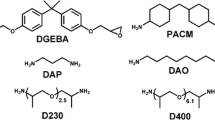Abstract
The ballistic performance of polydicyclopentadiene (pDCPD) was investigated and compared to two epoxy resins that a have similar glass transition temperature (Tg) to pDCPD. The ballistic performance of these materials (at an effective stain rate of 104–105 s−1) was characterized by determining the kinetic energy of the projectile where there is a 50 % probability that the projectile will penetrate a witness foil behind the sample (KE50). The ballistic performance of pDCPD showed a 300–400 % improvement over the structural epoxy resins. Typical, highly crosslinked epoxy networks become brittle at low temperatures, but pDCPD has a superior ballistic performance over a broad temperature range from (−55 to 75 °C), despite having a glass transition temperature of 142 °C, which characteristic of structural resins. pDCPD also exhibited a room temperature glassy storage modulus of 1.7 GPa, making pDCPD a potential structural resin that can overcome the structural vs. energy dissipation trade-off that commonly exists with some conventional crosslinked polymers. Quasi-static measurements of pDCPD when compared to epoxy resins suggested that the performance of pDCPD relates to higher fracture toughness and lower yield stress relative to typical epoxies, while molecular dynamics simulations comparing pDCPD to epoxy resins suggest that the performance of pDCPD is due to the lack of strong non-covalent interactions and the facile formation of nanoscale voids.
Access this chapter
Tax calculation will be finalised at checkout
Purchases are for personal use only
Similar content being viewed by others
References
Knorr Jr., D.B., et al.: Overcoming the structural versus energy dissipation trade-off in highly crosslinked polymer networks: ultrahigh strain rate response in polydicyclopentadiene. Compos. Sci. Technol. 114, 17–25 (2015)
Knorr Jr., D.B., et al.: Glass transition dependence of ultrahigh strain rate response in amine cured epoxy resins. Polymer 53(25), 5917–5923 (2012)
Masser, K.A., et al.: Relating structure and chain dynamics to ballistic performance in transparent epoxy networks exhibiting nanometer scale heterogeneity. Polymer 58, 96–106 (2015)
Elder, R.M., Andzelm, J.W., Sirk, T.W.: A molecular simulation study of the glass transition of cross-linked poly(dicyclopentadiene) networks. Chem. Phys. Lett. 637, 103–109 (2015)
McGrath, L.M., et al.: Investigation of the thermal, mechanical, and fracture properties of alumina–epoxy composites. Polymer 49(4), 999–1014 (2008)
Morye, S.S., et al.: Modelling of the energy absorption by polymer composites upon ballistic impact. Compos. Sci. Technol. 60(14), 2631–2642 (2000)
Deka, L.J., Bartus, S.D., Vaidya, U.K.: Damage evolution and energy absorption of E-glass/polypropylene laminates subjected to ballistic impact. J. Mater. Sci. 43(13), 4399–4410 (2008)
Zee, R.H., Hsieh, C.Y.: Energy absorption processes in fibrous composites. Mat. Sci. Eng. A Struct 246(1–2), 161–168 (1998)
Czarnecki, G.J.: Estimation of the V-50 using semi-empirical (1-point) procedures. Compos. Part B Eng. 29(3), 321–329 (1998)
Gellert, E.P., Cimpoeru, S.J., Woodward, R.L.: A study of the effect of target thickness on the ballistic perforation of glass-fibre-reinforced plastic composites. Int. J. Impact Eng. 24(5), 445–456 (2000)
Bain, E.D., et al.: Failure processes governing high-rate impact resistance of epoxy resins filled with core–shell rubber nanoparticles. J. Mater. Sci. 51(5), 2347–2370 (2015)
van der Sanden, M.C.M., Meijer, H.E.H.: Deformation and toughness of polymeric systems: 3. Influence of cross-link density. Polymer 34(24), 5063–5072 (1993)
Bielawski, C.W., Grubbs, R.H.: Living ring-opening metathesis polymerization. Prog. Polym. Sci. 32(1), 1–29 (2007)
Constable, G.S., Lesser, A.J., Coughlin, E.B.: Morphological and mechanical evaluation of hybrid organic-inorganic thermoset copolymers of dicyclopentadiene and mono- or tris(norbornenyl)-substituted polyhedral oligomeric silsesquioxanes. Macromolecules 37(4), 1276–1282 (2004)
Mukherji, D., Abrams, C.F.: Microvoid formation and strain hardening in highly cross-linked polymer networks. Phys. Rev. E 78(5), 050801 (2008)
Acknowledgement
This research was supported in part by an appointment to the Postgraduate Research Participation Program at the U.S. Army Research Laboratory administered by the Oak Ridge Institute for Science and Education through an interagency agreement between the U.S. Department of Energy and USARL.
Author information
Authors and Affiliations
Corresponding author
Editor information
Editors and Affiliations
Rights and permissions
Copyright information
© 2017 The Society for Experimental Mechanics, Inc.
About this paper
Cite this paper
Long, T.R. et al. (2017). Ballistic Response of Polydicyclopentadiene vs. Epoxy Resins and Effects of Crosslinking. In: Casem, D., Lamberson, L., Kimberley, J. (eds) Dynamic Behavior of Materials, Volume 1. Conference Proceedings of the Society for Experimental Mechanics Series. Springer, Cham. https://doi.org/10.1007/978-3-319-41132-3_37
Download citation
DOI: https://doi.org/10.1007/978-3-319-41132-3_37
Published:
Publisher Name: Springer, Cham
Print ISBN: 978-3-319-41131-6
Online ISBN: 978-3-319-41132-3
eBook Packages: EngineeringEngineering (R0)




